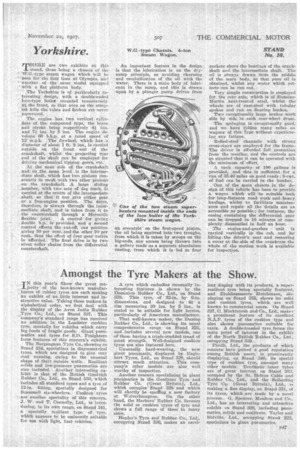Yorkshire.
Page 171

If you've noticed an error in this article please click here to report it so we can fix it.
THERE are two exhibits on thjs. stand, these being a chassis of the W.G.-type steam wagon which will be seen for the first time at Olympia. awl another of the same model equipped with a fiat platform body.
The Yorkshire is of particularly in' teresting design, with a double-ended loco-type boiler mounted transversely at: the front, so that even on the steepeat hills the tubes and firebox are never uncovered.
. The engine has two vertical cylieders of the compound type, the bores and stroke being respectively 41 ins.
• and 71 ins, by S ins. The engine develops 60 b.h.p. at a rated speed of 12.m.p.h. The flywheel, which has a diameter of about 1 ft. 8 ins., is carried , outside on the front end of the crankshaft, whilst the projecting rear end of the shaft can be employed for driving mechanical tipping gears, etc. , At the near side of the crankshaft andon the same level, is the interme.diate shaft, which has two pinions constantly in mesh with two other pinions on the crankshaft. A large sliding Member, with two sets of dog teeth, is carried at the centre of the intermediate
• shaft, so that it can give either gear or a free-engine position. The drive, therefore, is always through the inter-_ mediate shaft, and is taken from it to , the countershaft through • a Hermetic
flexible joint. A control for giving double hp. is provided, and a second
• control effects the cut-off, one position giving 50 per cent. and the other 70 per cent., thus the effect of four -gear ratios is afforded. The final drive is by two stout roller chains from the differential countershaft.
An important feature in the design Is that the lubrication is on the drysump principle, so avoiding churning and emulsification of the oil with the water. There is a main body of lubricant in the sump, and this is drawn upon by a plunger pump driven froni an eccentric on the first-speed pinion, 'the oil being squirted into two troughs, from which it is taken by scoops on the big-ends, any excess being thrown into a gallery made as a separate aluminium casting from which it is led to four
pockets above the bearings of the crankshaft and the intermediate shaft. The oil is always drawn from the middle of the main body, so that pure oil is obtained, whilst any water which collects can be run out.
Very simple construction is employed for the rear axle, which is of SiemensMartin heat-treated steel, whilst the' wheels are of cast-steel with tubular spokes and run on floating bushes.
Two exceptionally large brakes work side by side in each rear-wheel drum.
The springing is exceptionally good, and we have ridden many miles on wagons of this type without experiencing any fatigue.
Rolled-steel channels with strong cross-stays are employed for the frame. The driver is afforded full protection from the weather, and the controls are so situated that it can be operated with tlie minimum of effort.
A tank capacity of 100 gallons is provided, and this is sufficient for a • run'of 35-40 miles on good roads ; 8-cwt. of fuel can be carried in the bunker.
One of the main objects in the design of this vehicle has been to provide a wagon which will be suitable both -for Icing-distance road work and heavy haulage, whilst to facilitate maintenance and repair all the details are as accessible as possible ; for instance, the casing containing the differential gear can be dropped in 10 minutes or completely dismantled in half an hour.
The engine-and-gearbox unit is carried vertically in the cab, and by -lifting,the driver's seat and removing a cover at the side of the crankcase the whole of the motion work is available for inspection.


















































































































































































































































































































